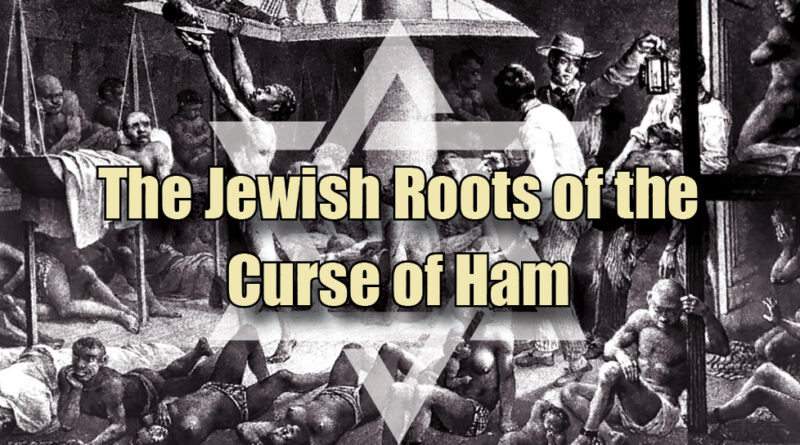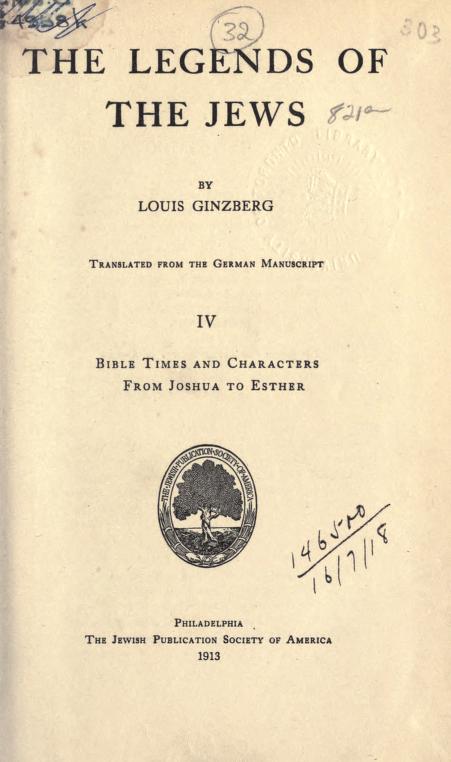The Jewish Roots of the Curse of Ham
How Rabbis Made Noah the ‘Father of Racism’
“I realized that the Bible had been written by white men. I knew that, according to many Christians, I was a descendant of Ham, who had been cursed, and that I was therefore predestined to be a slave. This had nothing to do with anything I was, or contained, or could become; my fate had been sealed forever, from the beginning of time. And it seemed, indeed, when one looked out over Christendom, that this was what Christendom effectively believed. It was certainly the way it behaved.”
—James Baldwin
The Jewish holy book Talmud is the progenitor of the overtly racist myth known as the Curse of Ham, or Hamitic Myth. According to the Talmudic rabbis, BLACKS are the people so cursed and they are destined to be made slaves of others—the “hewers of wood and drawers of water” for the other “blessed” non-Black races of humanity (Joshua 9:21). This “diabolic stain” applied to Black humanity—direct from the Talmudic Jews—formed the core of the racial belief system among Jews in the centuries before the time of Jesus, and long, long after.
“The original scripture called “The Torah” — revealed to Musa (Moses) — was Holy until the Jews and the Christian scholars started tampering with it. [….] I think when it comes to the word of Allah (God) or a book revealed by Him, that word or book is sacred and should be protected from corruption by the hands of people who care nothing for its sacredness. It is like a “rattlesnake” in the hands of my people, for they (most of them) do not understand it.”
—The Most Honorable Elijah Muhammad
The Book of Genesis is where we find the story of Noah’s Ark, maybe the most beloved biblical tale and the one most adapted to a child’s level of understanding. Noah, the central figure in the story, lived in a world of widespread corruption and evil, but he had earned the grace of GOD, Who considered him “righteous and blameless in his generations.” Indeed, Noah is said to have actually “walked with GOD.”
He tells all who will listen of a great and catastrophic flood that is to come and wash away all living things. The townspeople ridicule his prophecy and mock his work as he builds a great ark, gathers up two of every species of animal and his own family, climbs aboard, and awaits the deluge. For forty days and nights the rain is unceasing and all of humanity is washed away as punishment for their grievous sins.
Genesis thus provides an apocryphal tale of GOD’s warning, Noah’s obedience, and the consequences to a humanity in rebellion—all suited for youthful understanding. But that seemingly innocuous biblical parable has served as the perfect host for a profoundly racist virus, a poison that has infected and corrupted the entire world of religion, and even today guides governmental policy-making at every level.
Ten verses in the Book of Genesis (9:18–27) pick up Noah’s family saga after the great flood drowned all others. The water recedes, the ark makes landfall, and Noah emerges to populate and begin the world anew. The controversial episode is here recounted in the King James version:
And the sons of Noah, that went forth of the ark, were Shem, and Ham, and Japheth: and Ham is the father of Canaan. These are the three sons of Noah: and of them was the whole earth overspread. And Noah began to be an husbandman, and he planted a vineyard: And he drank of the wine, and was drunken; and he was uncovered within his tent. And Ham, the father of Canaan, saw the nakedness of his father, and told his two brethren without. And Shem and Japheth took a garment, and laid it upon both their shoulders, and went backward, and covered the nakedness of their father; and their faces were backward, and they saw not their father’s nakedness. And Noah awoke from his wine, and knew what his younger son had done unto him. And he said, Cursed be Canaan; a servant of servants shall he be unto his brethren. And he said, Blessed be the Lord God of Shem; and Canaan shall be his servant. God shall enlarge Japheth, and he shall dwell in the tents of Shem; and Canaan shall be his servant.
In that strange and convoluted passage Noah is empowered to split up the human family into thirds on the basis of how his sons handled or mishandled his drunken nakedness. Though Ham is the apparent offender, it is Ham’s son Canaan (and his offspring) that Noah curses forever to be servants of his uncles Shem and Japheth. The rabbis reason that Ham’s son Canaan was cursed—and not the culprit Ham—because GOD had previously blessed Noah and his three sons, including Ham (Gen. 9:1), and thus a cursing affecting Ham directly would be tantamount to insubordination on Noah’s part, a disobedient attempt to annul GOD’s decree.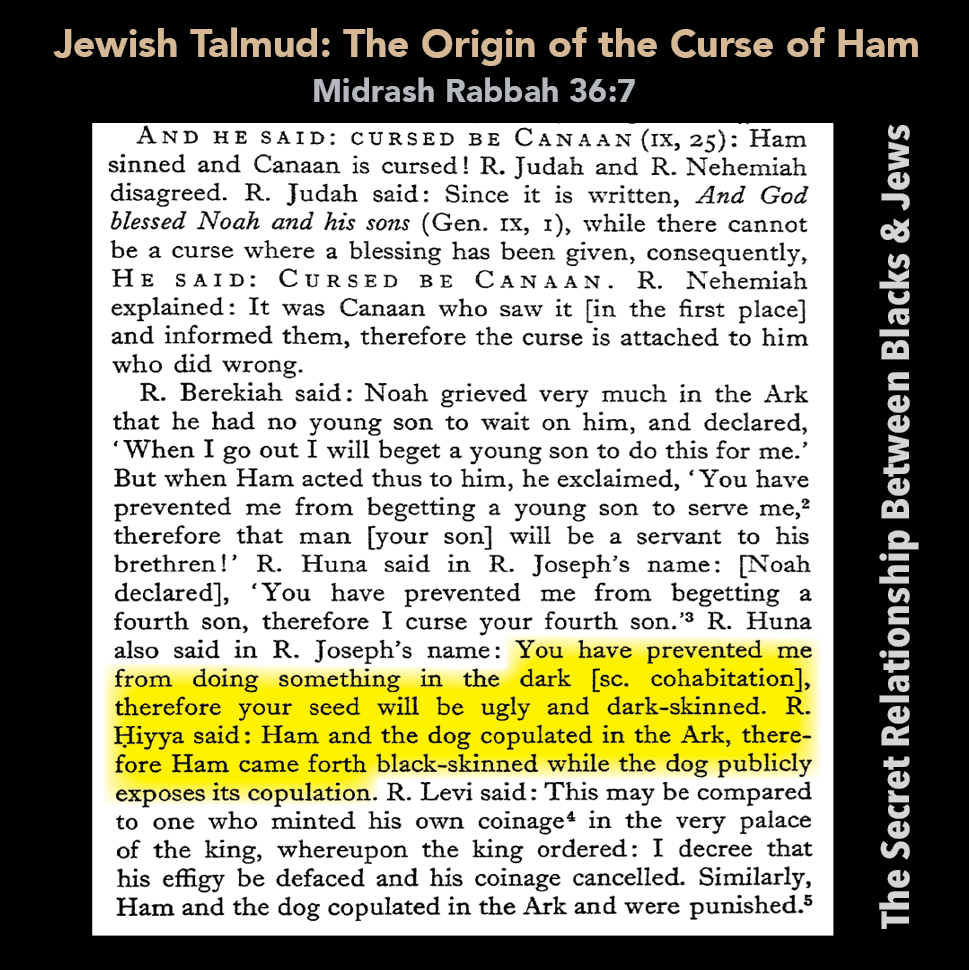
As odd as the story is, a careful reading of the verses finds no language indicating that the tale had anything to do with race or skin color at all. Yet, in this Old Testament tale the Talmudic rabbis saw an opportunity to create a racial world view, so they invented a new color-coded version of the Noah episode.
In the rabbis’ racialized version Noah’s son Ham doesn’t just view his father’s nakedness, he commits a violent homosexual act against him. When Noah realizes what his son has done to him, he curses Ham’s son Canaan and his offspring with black skin. But even though it was a drunken Noah—not God—who actually applied the curse, the Talmudic rabbis doubled down with several repugnant elaborations. The phrase “saw his father’s nakedness” was maliciously re-interpreted to mean that Ham “indulged a perverted lust upon him.” Another vile Jewish rendition has Ham actually castrating his father, who angrily cries out:
“You have prevented me from begetting a fourth son, therefore I curse your fourth son….You have prevented me from doing some-thing in the dark (having intercourse), therefore your seed will be ugly and dark-skinned.”
Talmud tractate Sanhedrin 108b introduces bestiality and pairs Ham with the animals on the ark. The rabbis assert that a skin-blackening sexual sin was committed on the ark even before Noah’s drunken impropriety:
“Three violated [God’s] directive and engaged in intercourse while in the ark, and all of them were punished for doing so. They are: The dog, and the raven, and Ham, son of Noah. The dog was punished in that it is bound; the raven was punished in that it spits, and Ham was afflicted in that his skin turned black.”
In their book Hebrew Myths, Robert Graves and Raphael Patai explain that the rabbis added even more negative characteristics to the Black man’s racial résumé—criminality, promiscuity, and dishonesty: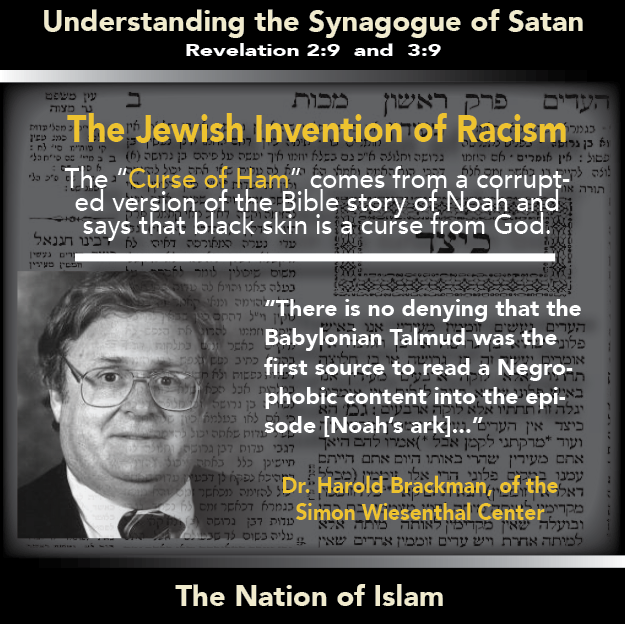
“Men of their race are called Negroes; their forefather Canaan commanded them to love theft and fornication, to be banded to-gether in hatred of their masters and never to tell the truth.”
Thus, in the various rabbinical interpretations of the original story of Noah we find themes of race hatred, bestiality, sodomy, castration, homosexuality, drunkenness, and promiscuity—all applied to the very nature of Ham and by extension to the cursed race he presumably fathered. Through this one absurd, calumnious Talmudic tale did all the alleged disabilities of the Black man and woman become irrevocably fixed: blackness; physical ugliness of hair, lips, eyes; criminality; sexual deviance; and even penis dimensions. The Simon Wiesenthal Center historian Dr. Harold Brackman explains:
“The more important version of the myth, however, ingeniously ties in the origins of blackness—and of other, real and imagined Negroid traits—with Noah’s Curse itself. According to it, Ham is told by his outraged father that, because you have abused me in the darkness of the night, your children shall be born black and ugly; because you have twisted your head to cause me embarrassment, they shall have kinky hair and red eyes; because your lips jested at my exposure, theirs shall swell; and because you neglected my nakedness, they shall go naked with their shamefully elongated male members exposed for all to see.”
According to the rabbinical authorities, all those cursings are the direct result of Noah’s irresponsible inebriation. Once the mark of intelligence, wisdom, beauty, strength, and virility, blackness itself was rabbinically transformed into the mark of degradation, savagery, and slavery. Noah’s two other sons, Japheth and Shem, in guarding their father’s dignity—in essence, hiding the sins of their father—were rewarded by the rabbis with fatherhood of the blessed races, the white Gentiles and the Caucasian Jews respectively.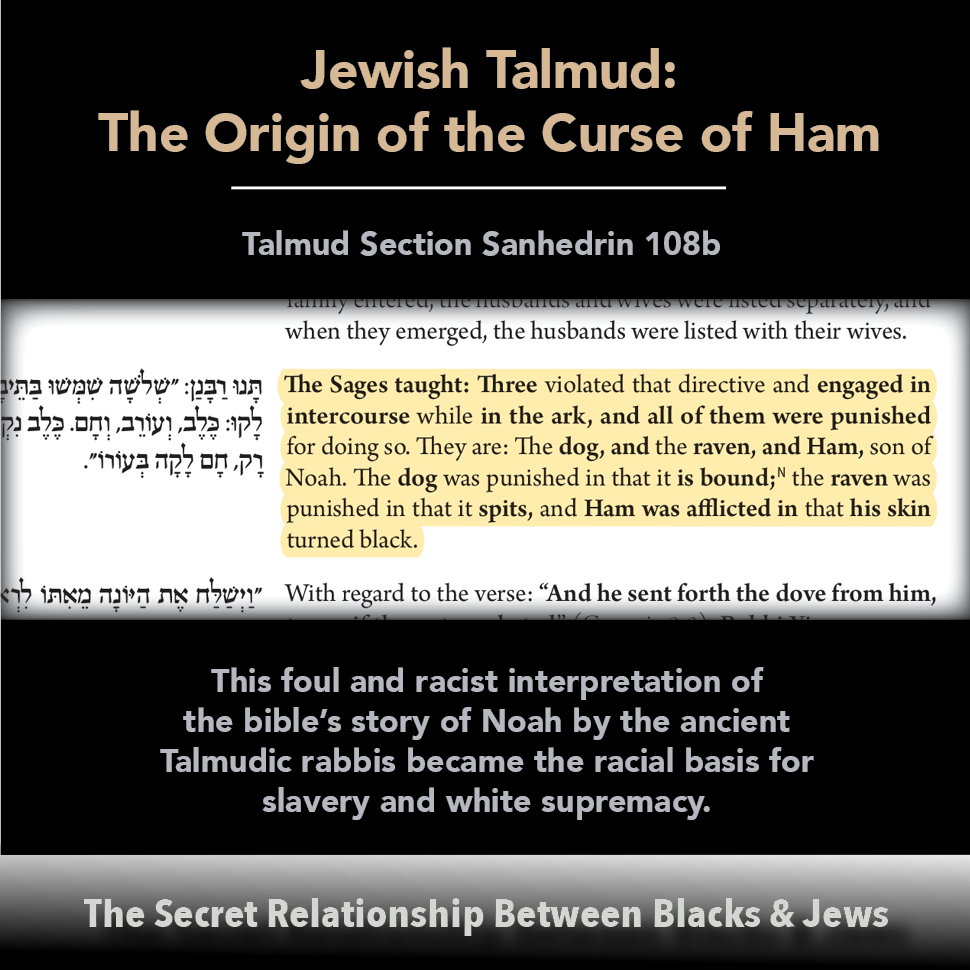
With their ability and position to translate Scripture (Septuagint ) the Talmudic rabbis explain the origin of the races, assign them their respective roles, and establish a ruling racial hierarchy. Quite diabolically, a benign Biblical fairytale for conveying life lessons to youthful minds became the vehicle by which the most wicked racial cruelty could be divinely justified.
In fact, the Talmud’s Curse of Ham is said to be the very invention of racism. Dr. Brackman concludes:
“[T]here is no denying that the Babylonian Talmud was the first source to read a Negrophobic content into the episode [of the story of Noah]…”
And so says Black theologian Dr. Charles Copher of the Interdenominational Theological Center in Atlanta:
“Racial myths [were] created and employed by the first interpreters of the so-called Old Testament, the ancient Jewish rabbis. They then continue through the use of myths inherited from the rabbis….As is well known, the Old Hamite Myth was used by Jews down through the ages, and was adopted by Euro-American interpreters of the Bible to justify the enslavement and later segregation of the Negroes.”
Motives for Rabbinical Racism
It was economic opportunity that motivated the rabbis to concoct their racist allegory. As Edith R. Sanders wrote, “Ideas have a way of being accepted when they become useful as a rationalization of an economic fact of life.” The authors of the book Hebrew Myths zeroed in on the economic motive as well:
“That Negroes are doomed to serve men of lighter color was a view gratefully borrowed by Christians in the Middle Ages: a severe shortage of cheap manual labor, caused by plague, made the re-institution of slavery attractive.”
And moving labor to where it is needed is historically a Jewish monopoly. As written in the Jewish Encyclopedia, Jewish traders of the Middle Ages dominated the early slave trade: “At the time of Pope Gregory the Great (590–604) Jews had become the chief traders in this class of traffic.” At first they did not distinguish their inventory on the basis of race. Over time, the skill, intelligence, strength, stamina, and disease-resistance of the Africans were seen as more marketable than the characteristics of all others, and a premium was placed on their sale. We see that preference being expressed today in the most physically demanding area of sports and athletics, where the physical dominance of the African is undeniable.
According to THE MOST HONORABLE ELIJAH MUHAMMAD, “From the first day that the white race received the Divine Scripture they started tampering with its truth to make it suit themselves.” Indeed, the oldest surviving Greek version of the Old Testament (Tanakh ) is traditionally said to have been translated from the original Hebrew by 70 or 72 Jewish scholars sometime during the third century BCE. So it may be speculated, then, that the ancient rabbis, enjoying the financial benefits of the slave trade, which enriched their entire Jewish community, distorted the original story of Noah to justify the new racial focus on the “GOD”-cursed African and locking into place their original Yakubian aim of mastering the Original Man.
How the Curse of Ham Was Spread
In biblical times ideas, as they are today, were spread the same way spices, rum, and pork bellies were spread—by way of the international merchants. Historian of religion Martin Hengel reports that one ancient Jewish document asserted that “Trade is a contract which brings in its train alien culture and certainly also alien religion.”
And since the Middle Ages—through the various media channels of the time—a tiny Talmudic mustard seed has become deeply rooted and has branched into a worldwide, universal creed. The Nation of Islam LESSONS provide a foundation for understanding the Talmudic propagandist’s methodology. We learn that Yakub’s grafted devils “started making trouble among the righteous people telling lies. They accused the righteous people causing them to fight and kill one another.” How were these devils able to get in “among the righteous”? THE LESSONS also say that we allowed them to “come and do trading among us…”
The Jewish Encyclopedia explains that the Hebrew term “rakil,” meaning slander, is derived from “rokel,” meaning peddler, “because the talebearer is like a peddler who ingratiates himself with his customers by telling one what another says about him.” One can easily see how such slanderous accusations and duplicitous behavior could cause his clientele “to fight and kill one another,” often while he sells both of them the weapons they’ll deploy.
The Hamitic Myth was spread far and wide and presented as divine guidance by self-serving Jewish slave merchants and their beneficiaries in the clergy, and by 1460 A.D. the institution of slavery would be universally believed to be the lot of the Black African.
While not explicitly citing the Noah of the Talmud, the greatest of all Jewish sages, Moses Maimonides, wrote in the 12th century that
“…the Negroes found in the remote South, and those who resemble them from among them that are with us in these climes. The status of those is like that of irrational animals. To my mind they do not have the rank of men, but have among the beings a rank lower than the rank of man but higher than the rank of apes.”
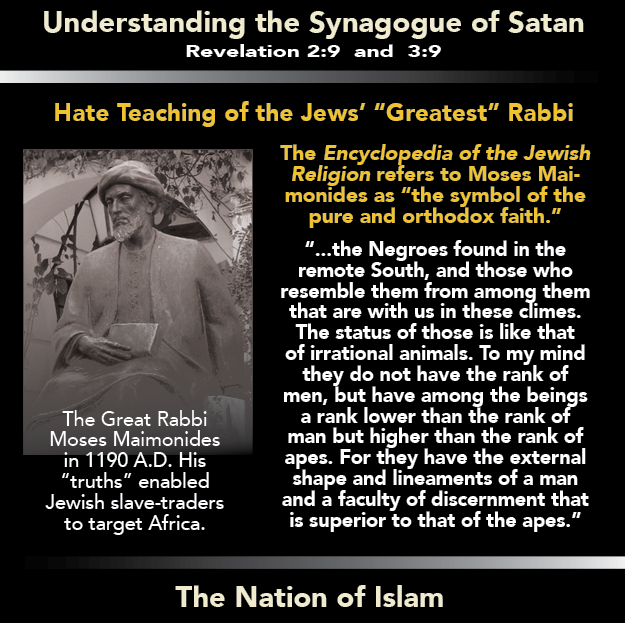
Through the millennia, the so-called Curse of Ham made its way throughout the known world via the well-traveled trade routes and port cities, where this and other Talmudic race notions leached into the marketplaces. Judaism’s infamous malediction was unresistingly adopted by all the major religions—Christianity, Hinduism, and Islam—and has been diabolically used by most religious faiths to reinforce the white supremacist leanings of their hierarchies.
Israeli professor of Jewish studies Dr. Abraham Melamed authored a devastating review of Jewish historical race hate titled The Image of the Black in Jewish Culture. In the introduction he writes that he had assumed that Jewish racism had been borrowed from “Islamic culture,” but he was “surprised” to find
“there was an internal and significant Jewish tradition identifying black as inferior other. It took shape in the writings of the [Talmudic] Sages…and had a profound effect on images of the black among medieval and early modern Jewish scholars.”
The Talmud, Dr. Melamed maintained, presented Blacks as inferior, animal-like, ugly, dirty, sexually promiscuous, violent, cruel, and by nature a treacherous slave.
“The Bible, as already noted, uses the black as an example of an unalterable state that in itself is not necessarily negative. The rabbis, by contrast, in the parallel that emerges between the wound and the black, provide a context that creates a negative association. Black skin is presented as a wound that does not heal—in every way a defect.
And from that racist rabbinical root all “Judeo-Christian” racial ethics were formed. All the world of religion bowed to the convenience of that Jewish Talmudic concept, and all the world’s colonizing cultures easily adopted the curse as essential to their economic pursuits.
White Supremacy & the Curse of Ham
The Hamitic Myth has been liberally applied whenever historical circumstances required the aggressive re-assertion of white supremacy. It can be shown to be at the root in the justification of the slave trade and the displacement and murder of the indigenous peoples of the Americas. It was used to attack the Civil Rights Movement, to undermine abolitionism, to buttress the proslavery Confederacy, and it was used as the instrument of control in Jim Crow.
Many people and groups have adopted the Hamitic Myth in some form, including the Puritans, the Jews, the Boers, the Afrikaners, and the Nazis, among many others. Even the Cherokees used it to justify their enslavement of the African (interestingly, it was “mixed-blood” Cherokees who engaged in this practice, just as it was “mulattos” who traded slaves on the African coast and who held African slaves in America). Ironically and tragically, Southern Christians then used the same Hamitic Myth to justify the extermination of the Cherokees. Christians further employed the “Chosen People” myth of the slaveholding ancient Hebrews to justify their own slaveholding. Whites have even gone so far as to say that the snake in the Garden of Eden was the Black Man.
The slave trade to the Islamic world put the Myth to full use, and Islamic clerics expounded on the curse of Blackness. Colonial missionaries like Cotton Mather of Massachusetts adopted the Hamitic Myth and it was roared from hundreds of American pulpits—North and South. Belgian colonizers appropriated to destroy the Tutsi and Hutu kingdoms, leading to the horrifying violence in Rawanda and Burundi. It is also said to be the basis of the 1896 Plessy v. Ferguson ruling. The founder of Mormons, Joseph Smith, and high official Brigham Young both used the Myth to condemn the Back man and exclude his participation in their cult. The Jehovah’s Witnesses readily printed it as fact in the Watchtower.
In various translations of the rabbinical texts, we find themes of bestiality, sodomy, castration, homosexuality, drunkenness, and promiscuity, all applied to the vary nature of Ham and by extension to the race he presumably fathered. The rabbi’s deviant sexual elaborations may have played a role in the feverish and overtly sexual violence against Blacks in the form of rapes and lynchings.
Black Acceptance
While not accepting its “natural slave” premise, Edward Wilmot Blyden accepted the African as a Hamite but tried to use the terminology to Black advantage. Others, like the enslaved poetess Phillis Wheatley, wrote of her color being a “diabolic dye.” Slave Jupiter Hammond imbibed fully the crudest of the Myth’s racist glosses. He admonished the Blacks who, improperly, think of freedom:
“It may seem hard for us if we think our masters wrong in holding us slaves to obey in all things, but who of us dare dispute with God! He has commanded us to obey, and we ought to do it cheerfully and freely….For my own part I do not wish to be free; for many of us who are grown up slaves have always had masters to take care of themselves; and it may be for our own comfort to remain as we are.”
Many other instances can be found of acceptance of the Myth as God’s will and wisdom by Blacks and their slavery-fashioned clerics.
SCHOLARS DISCUSSING the JEWISH HAMITIC MYTH
Harold Brackman, “The Ebb and Flow of Conflict”
Dr. Harold Brackman is a hired critic of the Nation of Islam and The Hon. Louis Farrakhan. He received his Ph.D. from the University of California in 1977 on the basis of a dissertation he wrote titled “The Ebb and Flow of Conflict: The History of Black-Jewish Relations Through 1900.” It is unpublished but Brackman’s 632-page dissertation discusses the Jewish invention of the profoundly racist Hamitic Myth. Brackman wrote:
“There is no denying that the [Jewish] Babylonian Talmud was the first source to read a Negrophobic content into the episode by stressing Canaan’s fraternal connection with Cush.”
The Jewish scholars, he said, advanced two explanations for Ham and his children being turned black. According to Brackman,
“The more important version of the myth, however, ingeniously ties in the origins of blackness — and of other, real and imagined Negroid traits — with Noah’s Curse itself. According to it, Ham is told by his outraged father that, because you have abused me in the darkness of the night, your children shall be born black and ugly; because you have twisted your head to cause me embarrassment, they shall have kinky hair and red eyes; because your lips jested at my exposure, theirs shall swell; and because you neglected my nakedness, they shall go naked with their shamefully elongated male members exposed for all to see.”
Louis Ginzberg’s Legends of the Jews (pages 168-170)
…God blessed Noah and his sons. He made them to be rulers of the world as Adam had been, and He gave them a command, saying, “Be fruitful and multiply upon the earth,” for during their sojourn in the ark, the two sexes, of men and animals alike, had lived apart from each other, because while a public calamity rages continence is becoming even to those who are left unscathed. This law of conduct had been violated by none in the ark except by Ham, by the dog, and by the raven. They all received a punishment. Ham’s was that his descendants were men of dark-hued skin…
…When Noah awoke from his wine and became sober, he pronounced a curse upon Ham in the person of his youngest son Canaan. To Ham himself he could do no harm, for God had conferred a blessing upon Noah and his three sons as they departed from the ark. Therefore he put the curse upon the last-born son of the son that had prevented him from begetting a younger son than the three he had.
The descendants of Ham through Canaan therefore have red eyes, because Ham looked upon the nakedness of his father; they have misshapen lips, because Ham spoke with his lips to his brothers about the unseemly condition of his father; they have twisted curly hair, because Ham turned and twisted his head round to see the nakedness of his father; and they go about naked, because Ham did not cover the nakedness of his father. Thus he was requited, for it is the way of God to mete out punishment measure for measure.
Canaan had to suffer vicariously for his father’s sin. Yet some of the punishment was inflicted upon him on his own account, for it had been Canaan who had drawn the attention of Ham to Noah’s revolting condition. Ham, it appears, was but the worthy father of such a son. The last will and testament of Canaan addressed to his children read as follows: “Speak not the truth; hold not yourselves aloof from theft; lead a dissolute life; hate your master with an exceeding great hate; and love one another.”
As Ham was made to suffer requital for his irreverence, so Shem and Japheth received a reward for the filial, deferential way in which they took a garment and laid it upon both their shoulders, and walking backward, with averted faces, covered the nakedness of their father. Naked the descendants of Ham, the Egyptians and Ethiopians, were led away captive and into exile by the king of Assyria, while the descendants of Shem, the Assyrians, even when the angel of the Lord burnt them in the camp, were not exposed, their garments remained upon their corpses unsinged. And in time to come, when Gog shall suffer his defeat, God will provide both shrouds and a place of burial for him and all his multitude, the posterity of Japheth.
Winthrop D. Jordan, White Over Black: American Attitudes Toward the Negro, 1550-1812 (1968), pages 17-19:
The logical complement to the question of the Negro’s change in color was whether the European by removing to a torrid climate would become darker or even black. Something of a consensus on this point emerged in the seventeenth century, since understandably Englishmen did not relish the prospect of turning into Negroes by prolonged residence in their expanding tropical empire. By the eighteenth century it was generally understood that European complexions would be darkened by tropical sun and weather, but that a return to cooler climates would restore the original color; even European children born in hot climates would be thoroughly white at first.
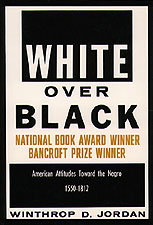 There was an alternative to these naturalistic explanations of the Negro’s blackness. Some writers felt that God’s curse on Ham (Cham), or upon his son Canaan, and all their descendants was entirely sufficient to account for the color of Negroes. This could be an appealing explanation, especially for men like George Best who wished to stress the “natural infection” of blackness and for those who hoped to incorporate the Negro’s complexion securely within the accepted history of mankind. The original story in Genesis 9 and 10 was that after the Flood, Ham had looked upon his father’s nakedness as Noah lay drunk in his tent, but the other two sons, Shem and Japheth, had covered their father without looking upon him; when Noah awoke he cursed Canaan, son of Ham, saying that he would be a “servant of servants” unto his brothers. Given this text, the question becomes why a tale which logically implied slavery but absolutely nothing about skin color should have become an autonomous and popular explanation of the Negro’s blackness. Probably, over the very long run, this development was owing partly to the ancient association of heat with sensuality and with the fact that some Ethiopians had been enslaved by Europeans since ancient times.
There was an alternative to these naturalistic explanations of the Negro’s blackness. Some writers felt that God’s curse on Ham (Cham), or upon his son Canaan, and all their descendants was entirely sufficient to account for the color of Negroes. This could be an appealing explanation, especially for men like George Best who wished to stress the “natural infection” of blackness and for those who hoped to incorporate the Negro’s complexion securely within the accepted history of mankind. The original story in Genesis 9 and 10 was that after the Flood, Ham had looked upon his father’s nakedness as Noah lay drunk in his tent, but the other two sons, Shem and Japheth, had covered their father without looking upon him; when Noah awoke he cursed Canaan, son of Ham, saying that he would be a “servant of servants” unto his brothers. Given this text, the question becomes why a tale which logically implied slavery but absolutely nothing about skin color should have become an autonomous and popular explanation of the Negro’s blackness. Probably, over the very long run, this development was owing partly to the ancient association of heat with sensuality and with the fact that some Ethiopians had been enslaved by Europeans since ancient times.
What is more arresting, there did exist a specific textual basis for utilizing the curse as an explanation for blackness—but it was a specifically Jewish rather than a Christian one. The writings of the great church fathers such as St. Jerome and St. Augustine referred to the curse in connection with slavery but not with Negroes. They casually accepted the assumption that Africans were descended from one or several of Ham’s four sons, an assumption which became universal in Christendom despite the obscurity of its origins. They were probably aware, moreover, that the term Ham originally connoted both “dark” and “hot,” yet they failed to seize this obvious opportunity to help explain the Negro’s complexion. In contrast the approximately contemporaneous Talmudic and Midrashic sources contained such suggestions as that “Ham was smitten in his skin,” that Noah told Ham “your seed will be ugly and dark-skinned,” and that Ham was father “of Canaan who brought curses into the world, of Canaan who was cursed, of Canaan who darkened the faces of mankind,” of Canaan “the notorious world-darkener.”
While it probably is not possible to trace a direct line of influence, it seems very likely that these observations affected some Christian writers during the late Medieval and Renaissance years of reviving Christian interest in Jewish writings. It is suggestive that the first Christian utilizations of this theme came during the sixteenth century—the first great century of overseas exploration. As should become clear in this chapter, there was reason for restless Englishmen to lay hold of a hand-me-down curse which had been expounded originally by a people who had themselves restlessly sought a land of freedom.
…The extraordinary persistence of this idea in the face of centuries of incessant refutation was probably sustained by a feeling that blackness could scarcely be anything but a curse and by the common need to confirm the facts of nature by specific reference to Scripture. In contrast to the climatic theory, God’s curse provided a satisfying purposiveness which the sun’s scorching heat could not match until the eighteenth century. The difficulty with the story of Ham’s indiscretion was that extraordinarily strenuous exegesis was required in order to bring it to bear on the Negro’s black skin. Faced with difficulties in both the climatic and Scriptural explanation, some seekers after truth threw up their hands in great humility and accounted blackness in the African another manifestation of God’s omnipotent providence. This was Peter Heylyn’s solution (at least in 1627).
“Slavery in Mosaic Law,” The Secret Relationship Between Blacks and Jews, Vol. One
“Both biblical and rabbinic law permitted Jews to own slaves in all ages wherever slavery was in general practice….[L]iving in a society where slavery was an established institution, the Jews could hardly be expected to eliminate it.” —Rabbi Henry Cohen
Bible Verses Used to Justify Slavery
1 Chron. 18:11; 2 Sam. 20:23 (foreign mercenaries)
Josh. 9:21-27; Num. 31:26-47 (hewers of wood…)
2 Kings 5:20-27 (only other Biblical curse with skin change–to white)
Jesus had Canaanite blood; 1 of the 12 Apostles was a Canaanite (Mat 10:4)
Gen 17:13; Lev 25:24, 42-6 (condone slavery; 2 types of slavery)
Exod 20:10, 17 (protects slaves)
Matt 8:5-13 (accepts slavery)
Eph 6:5-9; Col 3:22-4:1; I Tim 6:3-4 (Paul approves slavery)
The holy laws of Judaism have never prohibited slavery or prevented all of its associated crimes and abuses. Black Africans were made brutally aware of this fact as their relationship with Jews developed. According to Jewish law, a Jew who buys an adult “heathen” male slave must have him circumcised. If the slave refuses after a year of attempts, the Jew must sell the slave to a “heathen.” In order to keep an uncircumcised slave, the slave must agree to obey the seven commandments of the descendants of Noah. New World Jews, however, made no attempt to convert their slaves to Judaism. In addition to slavery, Jewish law as exemplified throughout the Talmud permitted the exploitation and oppression of the Gentile.
Jewish slave-dealing in the American frontier was in direct conflict with the writings in Deuteronomy (23:15, 16) which insists that he who “is escaped from his master unto thee shall dwell with thee [and] thou shalt not oppress him.” But it is the Talmud which offered the holy justification for oppression on purely racial grounds. It suggested that “Ham was smitten in his skin” and it was Noah who told Ham that his “seed will be ugly and dark skinned.” It was this mis-interpretation of the scripture which the New World Jews chose to embrace. Even though slavery—more accurately described as an apprenticeship system—was Biblically permitted, the brutality of the system practiced by the European Jew upon the African was unprecedented. Dr. Feingold has found that among the ancient Hebrews, Biblical slavery
was of a precapitalist variety and had virtually no commerce connected with it. Unlike the situation in the plantation South, it did not shape the pastoral economy of ancient Israel which in any case found little use for masses of slaves. Rather than being considered an animated tool, as he was in the South, the slave in ancient Israel was merely a member of society in dependent status. He was entitled to the full protection of the laws of the community.
Philip Birnbaum stated plainly in his work A Book of Jewish Concepts that there is no evidence that slave markets ever existed in Israel. “Kidnapping a man or selling him as a slave was a capital offense. A fugitive slave law, which once permitted in America the act of tracking runaway slaves by bloodhounds, would have been unthinkable in ancient Israel, where the relationship between master and slave was often cordial. The slave sometimes inherited the property of his master (Genesis 15:2-3) and was sometimes admitted into the family as a son-in-law (I Chronicles 2:34-35).” According to a statement in the Talmud, the rabbinical interpretation of the law of God, the Hebrew slave was to be regarded as his master’s equal.
-
- “You should not eat white bread, and he black bread; you should not drink old wine, and he new wine; you should not sleep on a featherbed, and he on straw. Hence, it has been declared that whoever acquires a Hebrew slave acquires a master.”
- “A son or pupil may, but a Hebrew slave may not wash his master’s feet or help him put on his shoes…”
- “Though the Torah permits us to impose hard work on a Canaanite (non-Jewish) slave, piety and wisdom command us to be kind and just” (Yad, Avadim 9:8). “Freed slaves were considered proselytes, converts to Judaism, in every respect.”
- “‘Mercy is the mark of piety,’ says the Shulchan Aruch, quoting the language of far earlier authorities, ‘and no man may load his slave with a grievous yoke. No non-Jewish slave may be oppressed; he must receive a portion from every dainty that his master eats; he must be degraded neither by word nor act; he must not be bullied nor scornfully entreated; but must be addressed gently, and his reply heard with courtesy.'”10
- “You should not eat white bread, and he black bread; you should not drink old wine, and he new wine; you should not sleep on a featherbed, and he on straw. Hence, it has been declared that whoever acquires a Hebrew slave acquires a master.”
The practice of Judaism did, at times, include the assistance of the Black slaves. In seventeenth-century Mexico, the Jews had a curious religious ritual: “A Negro was dressed in a red suit and went through the streets playing a tambourine. This was the signal to congregate for a special community meeting or for prayer.”
The brutality of slavery with the participation of the Jewish people shows that whatever humane guidance that Judaism provided was thoroughly ignored.
^^
For more on this topic see the Nation of Islam book series The Secret Relationship Between Blacks & Jews. Download the free guide by clicking here.
To purchase the series click here.
“The Bible is the graveyard of my poor people (the so-called Negroes) and I would like to dwell upon this book until I am sure they understand that it is not quite as holy as they thought it was. I don’t mean to say that there is no truth in it; certainly, there is plenty of truth, if understood.”
—The Most Honorable Elijah Muhammad
“I don’t know of any scriptural book of religion that doesn’t contain some good. What Allah (God) demands today is a book or religion that is all good, not a mixture of truth and false, not a book or religion that is or has been tampered with by His enemies.”
—The Most Honorable Elijah Muhammad

